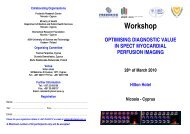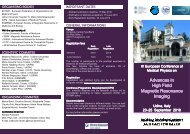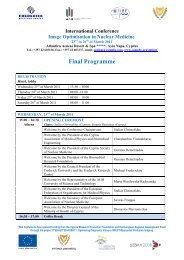medical physics international - Cyprus Association of Medical ...
medical physics international - Cyprus Association of Medical ...
medical physics international - Cyprus Association of Medical ...
- No tags were found...
Create successful ePaper yourself
Turn your PDF publications into a flip-book with our unique Google optimized e-Paper software.
MEDICAL PHYSICS INTERNATIONAL Journal, vol.1, No.1, 2013regularly to the progress in these fields. The main parts <strong>of</strong>this module have to include more detail about:- Magnetic Resonance ImagingPhysics <strong>of</strong> MRI; MRI Instrumentation; K-space;Different MR imaging methods; Pulse sequences; MRContrast and Image quality; Health and Safety; MRSpectroscopy; Flow imaging; Perfusion, Diffusion andFunctional MRI; Three dimensional reconstruction; Clinicalapplications <strong>of</strong> MRI; Image artefacts; Inter-relationshipbetween <strong>medical</strong> imaging techniques.- Ultrasound ImagingUS wave motion and propagation; Acoustic properties <strong>of</strong>biological media; Acoustic radiation fields; Safetymeasures; Transducers; A-mode; B-scanning; DopplerUltrasound; Image artefacts; Blood flow measurements;Measurement <strong>of</strong> acoustic power; Clinical applications <strong>of</strong> USimaging; Image artefacts; Inter-relationship between<strong>medical</strong> imaging techniques.<strong>Medical</strong> Imaging Physics and Equipment 2 ~10%(ionizing radiation – X-ray, Nuclear Medicine)This module aims to educate students in the <strong>physics</strong> <strong>of</strong><strong>medical</strong> imaging with ionising radiation (X-ray and NuclearMedicine Imaging). Due to the rapid development <strong>of</strong> theseimaging modalities the module is expected to adaptregularly to the progress in these fields. The main parts <strong>of</strong>this module have to include more detail about:- Diagnostic RadiologyX-rays production and equipment; Interaction <strong>of</strong> X-rayswith matter; Radiological image quality; X-ray detectors:Film, Image Intensifier, Storage phosphor, Flat panel;Scatter radiation and filtering; X-Ray ComputedTomography; Scanner configurations; Reconstruction types;CT image display, windowing, CT numbers; X-ray patientdosimetry and protection; Optimization techniques; Clinicalapplications; Image artefacts; Inter-relationship between<strong>medical</strong> imaging techniques.- Nuclear Medicine ImagingRadionuclides and production <strong>of</strong> Radiopharmaceuticals;Disease-specific radiopharmaceuticals; Radiation protectionin Nuclear Medicine; Image quality and noise; NuclearMedicine instrumentation and quality control: Gammacamera, SPECT, PET, SPECT/PET-CT, etc; Optimizationtechniques; General imaging principles, cardiac imaging,multigated studies, first pass studies, renal studies,modelling; Image artefacts; Inter-relationship between<strong>medical</strong> imaging techniques.Radiotherapy Physics and Equipment ~15%This module aims to provides the necessary backgroundfor the support <strong>of</strong> Radiotherapy Physics activities. Due tothe rapid development <strong>of</strong> this field the module is expectedto adapt regularly to the Radiotherapy progress. The mainparts <strong>of</strong> this module have to include more detail about:Interaction <strong>of</strong> radiation with tissues; Radiobiology inRadiotherapy; Radiotherapy dosimetry; External beamradiation and treatment planning; Megavoltage LinearAccelerator; Radiobiology in Radiotherapy; Radiotherapywith particle beams; Brachytherpay: High dose rate (HDR)treatments; Low dose rate (LDR) permanent implants;Beam models and planning tools; Treatment room design,machine commissioning and networking; Imaging inRadiotherapy; Quality management in Radiotherapy;Principles <strong>of</strong> Clinical application.VALIDATION OF THE PROGRAMMEUsually a small country will have no experience in settingand accrediting a suitable post-graduate programme(course) in <strong>Medical</strong> Physics. Validating the programme byan experienced body will assure the local University (orMinistry <strong>of</strong> Education) that this programme is in line withthe <strong>international</strong> standards. Additionally, the fact that theMSc graduates will work in Hospital environment(indirectly involved with patient health), makes the externalvalidation an important element <strong>of</strong> the educational process.IOMP has significant expertise allowing the provision <strong>of</strong>validation <strong>of</strong> such post-graduate programmes in <strong>Medical</strong>Physics and has set up <strong>of</strong> a special Validation andAccreditation Panel (VAP) <strong>of</strong> experts to the ETCCommittee. This Panel (or sub-committee) could not onlyassess and validate the programmes, but could also provideExternal Examiners and suggest suitable lecturers. Theactivities, terms and internal rules <strong>of</strong> the VAP are still indiscussion. It is expected Validation activities <strong>of</strong> the IOMPto be implemented during the period 2011-2012. These willinclude: Validation requirements; Application Form,Validation Procedure and Validation Certificate (all to befound at the IOMP web site at implementation stage).CONCLUSIONThe project for <strong>Medical</strong> Physics Model Curriculum, wasdeveloped by leading specialists and approved by the IOMPETC. It presents a background for initiation <strong>of</strong> new MSccourses. Part <strong>of</strong> the project has been used in the new IAEAProject Post-graduate <strong>medical</strong> <strong>physics</strong> academicprogrammes20






